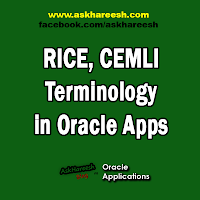RICE:
Oracle Corporation introduced RICE terminology. RICE stands for
- Reports
- Interfaces
- Conversions
- Enhancements / Extensions
- Creation of Reports that are not available as standard reports in the oracle apps modules.
- Creation of the Interfaces to external systems.
- Creation of Conversion programs to transfer data from a legacy system to the new system.
- Enhancements (or extensions) to the existing system to add additional functionality to existing system without disturbing the core software functionality of the system.
CEMLI:
Oracle corporation extended the RICE components and introduced as CEMLI components in R12 in 2007. CEMLI Stands for Configurations/Customization, Extension, Modification, Localization, and Integration.
- Configurations : Configure the existing, pre-built application features according to your client’s requirement.Changing setups and profile values can be the example of configurations.
- Customization : Customization means altering/changing the standard objects or creation of custom object to meet client’s business need. It may be Extensions or Modifications.
- Extensions : Extension means creating custom code from scratch, existing objects (views, packages and java classes etc) can be used. It is having different behaviour from seeded one.
- Modifications : Modifications is enhancing/changing the existing code to meet the client’s requirements. It is the modification of seeded behaviour.
- Localization : It is to define the different legislative support provided by oracle Applications based on country/region/language requirements.
- Integration : It can be Data Integration or Application Integration, options for these two are Open Interface tables, APIs, EAI(Enterprise Application Integration Tools), BPEL, AQ, EDI etc.

